Physical Address
304 North Cardinal St.
Dorchester Center, MA 02124
Definition: degeneration affecting the macula; characterized by drusen and RPE changes, and sometimes CNV.
Classification: non-exudative (‘dry’)—most common, and exudative (‘wet’); the latter is associated with more rapid progression to advanced sight loss.
Importance: most common cause of irreversible visual loss in industrialized countries; advanced age-related macular degeneration (AMD) in one eye confers a 50% chance of advanced AMD in the fellow eye within 5 years.
Risk factors: (a) age, (b) race (higher in Caucasians), (c) family history (several genes implicated), (d) smoking (doubles risk), (e) dietary factors (e.g. high fat intake), and (f) others (cataract surgery, blue iris colour, sunlight).
Pathogenesis: extracellular deposits at the interface between the RPE and Bruch membrane, derived from immune-mediated and metabolic processes in the RPE.
‘Hard’ drusen: well-defined and small (less than half a retinal vein width; Fig. 14.1 ); their presence in isolation carries little risk of visual loss.
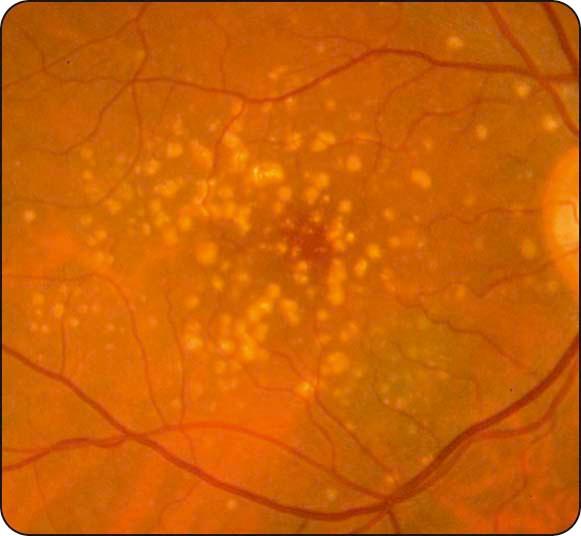
‘Soft’ drusen: less distinct and larger than hard drusen; numerous large soft drusen ( Fig. 14.2 ) are associated with a high risk of visual loss, including progression to CNV.
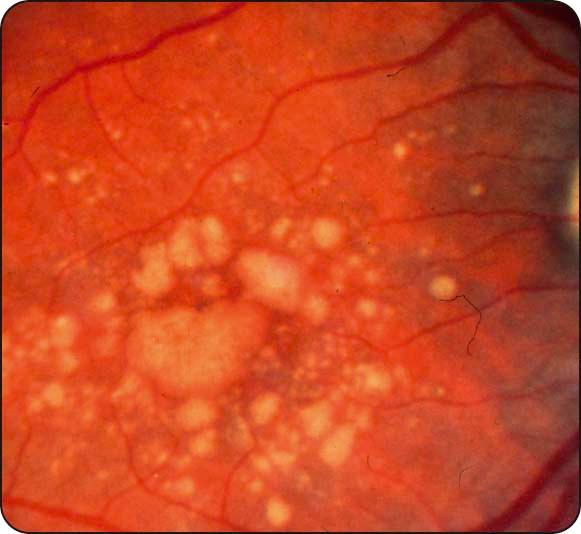
‘Drusenoid RPE detachment’: caused by coalesce of soft drusen resulting in a localized elevation of the RPE, a ‘drusenoid RPE detachment’ ( Fig. 14.3 ).
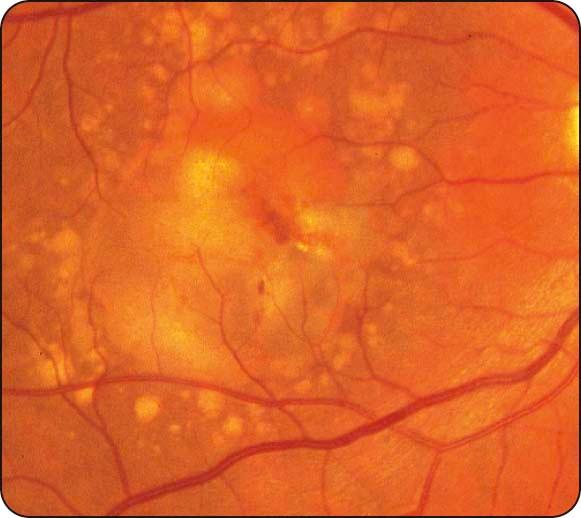
The Age-Related Eye Disease Study (AREDS) established that taking high-dose antioxidant vitamins and minerals on a regular basis can decrease the risk of AMD progression.
Indications: those aged older than 55 years with one or more of the following high-risk characteristics (extensive intermediate-sized drusen, at least one druse over 125 µm, geographic atrophy, advanced AMD in one eye); treatment confers a reduction in risk of up to 25% at 5 years.
AREDS regimen: vitamins C and E, beta-carotene, zinc, and copper; possible adverse effects include an increased risk of lung cancer in smokers.
Other measures: (a) macular xanthophylls (lutein and zeaxanthin) and omega-3 fatty acids, (b) adequate leafy green vegetable intake; (c) cessation of smoking and avoidance of excessive sunlight should also be considered.
Diagnosis
Presentation: gradual impairment of central vision over months or years in one or both eyes.
Signs: (a) numerous intermediate–large soft drusen, (b) focal RPE changes, and (c) areas of chorioretinal atrophy ( Fig. 14.4 ).
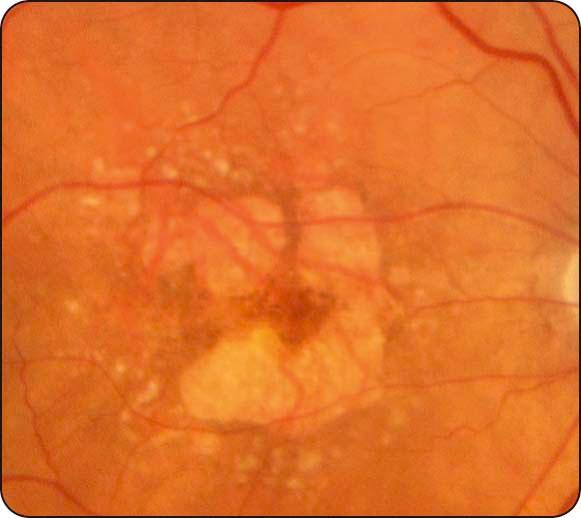
Course: enlargement of atrophic areas to give ‘geographical atrophy’ ( Fig. 14.5 ) with disappearance of pre-existing drusen.
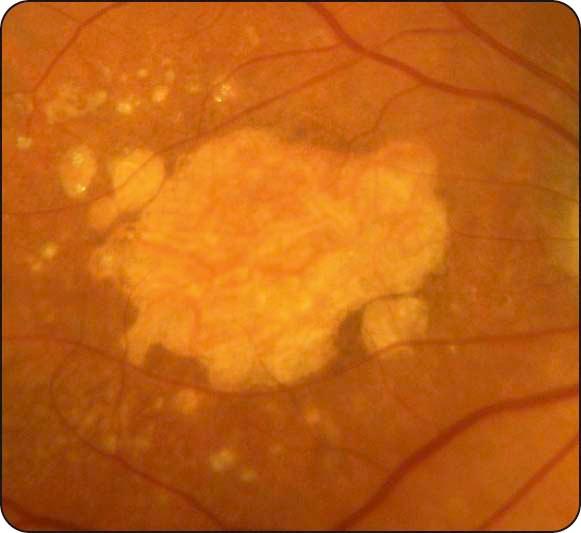
FA: window defect if the choriocapillaris is still intact; exposed sclera may exhibit late staining.
Treatment: prophylactic antioxidant supplementation; experimental surgical options (e.g. intraocular telescope implantation, retinal translocation, implantable photosensitive chip).
Pathogenesis: separation of the RPE from Bruch's membrane caused by disruption of the physiological forces maintaining adhesion.
Diagnosis
Serous retinal pigment epithelial detaclment (PED): orange dome-shaped elevation with sharply delineated edges ( Fig. 14.6a ); subretinal blood or lipid and irregularly distributed fluid are suggestive of underlying CNV.
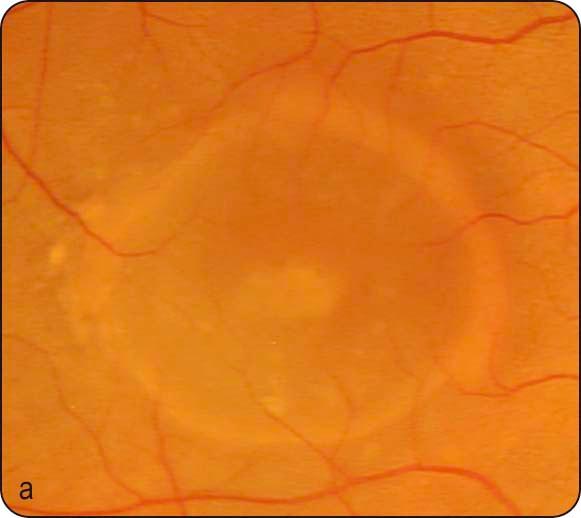
Imaging of serous PED: (a) FA shows a well-demarcated oval area of hyperfluorescence increasing in intensity but not area—‘pooling’—in which a notch may indicate CNV ( Fig. 14.6b ), (b) ICGA shows an oval area of hypofluorescence and a faint ring of surrounding hyperfluorescence ( Fig. 14.6c ), and (c) OCT shows separation of the RPE from Bruch's membrane by an optically empty area ( Fig. 14.6d ).
Course of serous PED: (a) gradually increasing atrophy and an eventual VA of 6/60 or less; (b) spontaneous resolution can occur, sometimes with visual improvement but often leaving geographic atrophy; and (c) rapid visual loss is typical of associated CNV (over 30%) or RPE tear formation (see below).
Fibrovascular PED: (a) a form of ‘occult’ CNV, much more irregular in outline and elevation than serous PED; (b) FA shows markedly irregular granular or ‘stippled’ hyperfluorescence, with uneven filling of the PED, leakage, and late staining; (c) OCT shows an optically denser lesion than serous PED.
‘Drusenoid’ PED: (a) shallowly elevated pale area with irregular scalloped edges; (b) FA shows diffuse hyperfluorescence, and (c) OCT shows homogeneous hyperreflectivity.
Haemorrhagic PED: virtually all eyes have underlying CNV or polypoidal choroidal vasculopathy (see below); (a) presentation is with sudden impairment of central vision, and prognosis is poor, (b) a dark red dome-shaped lesion is seen on examination, and (c) FA shows dense masking but with overlying vessels visible.
Treatment
Serous PED: observation may be appropriate in eyes without CNV, especially in younger patients. Options for CNV are (a) intravitreal anti-VEGF agents, (b) PDT, and (c) intravitreal triamcinolone, often in combination.
Fibrovascular PED: as for serous PED with CNV.
Drusenoid PED: observation in most cases.
Haemorrhagic PED: see below for management of polypoidal choroidal vasculopathy (PCV) and small CNV.
Become a Clinical Tree membership for Full access and enjoy Unlimited articles
If you are a member. Log in here